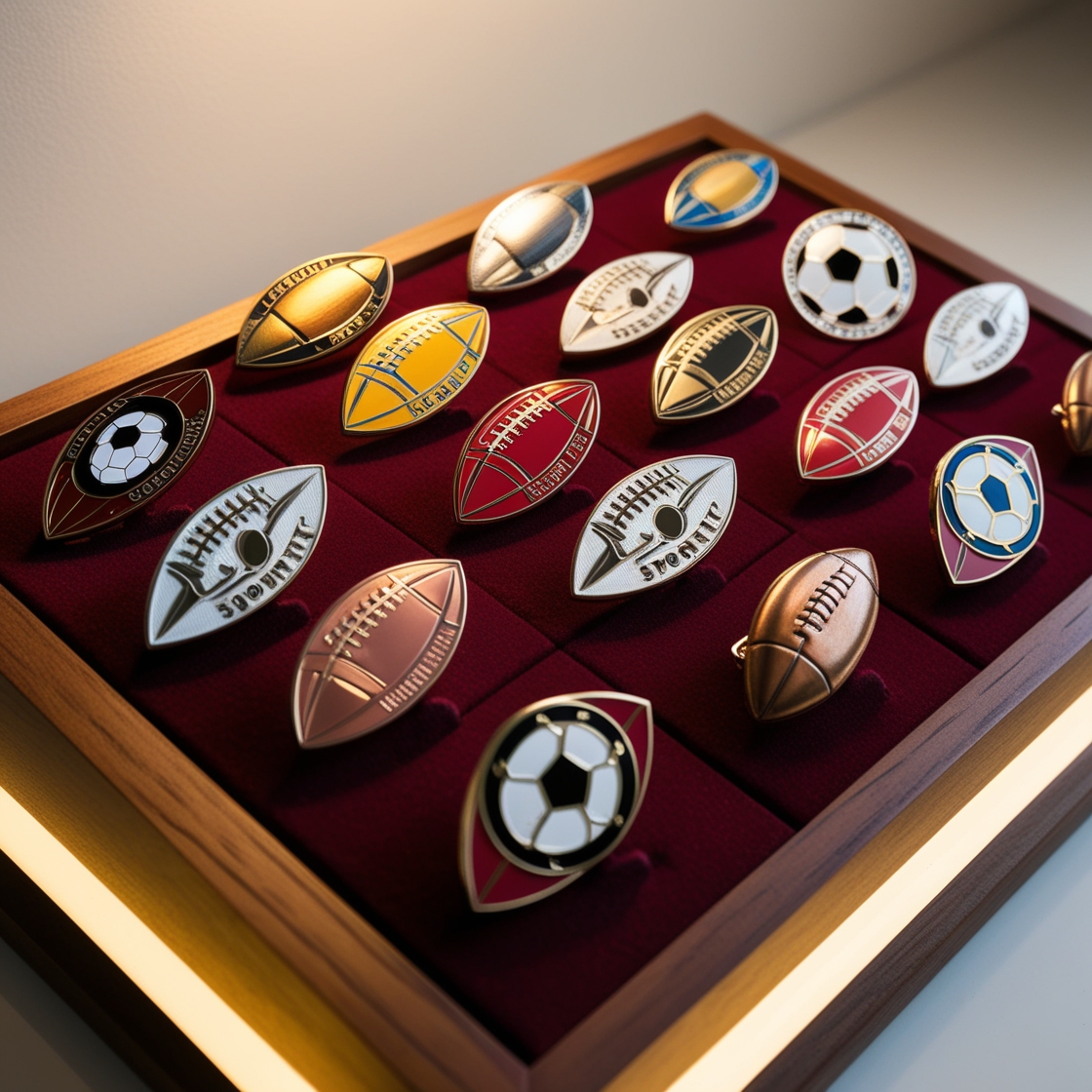In the vast world of sports memorabilia, items like autographed jerseys, trading cards, and game-worn gear tend to dominate the conversation. However, one unsung hero of the collector’s market is steadily rising in popularity: the humble lapel pin. These small, often intricately designed items have transformed from simple fan accessories into high-value collectibles sought after by both casual sports fans and serious memorabilia collectors.
For decades, sports lapel pins have been used to celebrate teams, commemorate significant events, and serve as a means for fans to showcase their loyalty. But as the sports memorabilia market has evolved, so too has the role of the lapel pin. What was once a low-cost, mass-produced item now holds historical value, with certain designs fetching high prices in auctions and collector’s markets. The unique blend of nostalgia, rarity, and aesthetic appeal has elevated sports lapel pins to a new status as highly prized collectibles.
This article delves into the true worth of sports lapel pins, exploring their journey from fan favorites to high-value memorabilia. We will discuss the history of lapel pins in sports, their growing significance in the collector’s world, and the factors that influence their value. Whether you’re a seasoned collector or a sports fan looking to start a pin collection, this guide will help you understand why lapel pins have become an essential piece of sports memorabilia.
1. The Origins of Sports Lapel Pins: From Early Days to Modern Collectibles
Lapel pins have a long history in sports, dating back to the early 20th century. They were first introduced as a way for fans and athletes to display their loyalty to a team or event. As professional sports leagues became more established, lapel pins became common giveaways at major events such as championship games, opening days, and international competitions like the Olympics.
1.1. Early Beginnings: Commemorative Pins in the 1900s
The early 1900s saw the rise of lapel pins in baseball, one of America’s favorite pastimes. During this period, baseball fans could buy small enamel pins featuring their team’s logo or mascot. These early pins were not only worn to games but also collected as keepsakes to commemorate important events, such as a team’s first season or a championship win.
Pins were also distributed to athletes and officials at major events. For example, the Olympic Games have used pins since the early 20th century to identify athletes, officials, and VIPs. These pins soon became sought after by spectators, and the practice of pin trading at the Olympics was born. As sports expanded globally, so did the popularity of lapel pins.
- Example: Vintage baseball pins from teams like the New York Yankees or Boston Red Sox, particularly those made in the 1920s and 1930s, are highly sought after today. Collectors pay a premium for pins from championship-winning teams or significant games in sports history.
- Pro Tip: When searching for older pins, focus on teams with rich histories or pins that were produced in limited quantities. Older pins, particularly those tied to specific events or seasons, tend to appreciate significantly in value over time.
1.2. The Evolution of the Sports Pin Market
As sports fandom grew throughout the 20th century, so did the variety of lapel pins offered to fans. Major sports leagues like the NFL, MLB, NBA, and NHL began producing pins for all-star games, playoffs, and championships. Many of these pins were limited editions, produced in small runs and sold exclusively at events, making them instantly collectible.
By the late 20th century, lapel pins had become an integral part of sports memorabilia, with fans clamoring for limited-edition releases at major sporting events. Pin trading also took off, particularly at large-scale events like the Olympics and Little League World Series, where fans and collectors would exchange pins as a way to connect and commemorate their shared experiences.
- Pro Tip: Focus on collecting pins from significant sporting events, such as Super Bowls, World Series, or major international tournaments like the FIFA World Cup. Limited-edition or event-exclusive pins often appreciate in value, especially when tied to memorable moments in sports history.
2. The Rise of Sports Lapel Pins as High-Value Collectibles
Over the past few decades, the sports memorabilia market has exploded, with items like jerseys, trading cards, and game-used equipment fetching astronomical prices. While lapel pins may not command the same immediate attention, certain pins have proven to be highly valuable in the long term. Today, the market for sports lapel pins is growing, with collectors recognizing their historical significance and aesthetic appeal.
2.1. The Role of Nostalgia in Driving Pin Value
One of the main factors contributing to the rise in value of sports lapel pins is nostalgia. For many collectors, pins serve as tangible reminders of their favorite teams, games, or personal experiences attending sporting events. This sense of nostalgia fuels demand for older pins, particularly those tied to significant moments in sports history.
- Example: Pins from iconic sports events, such as the 1980 “Miracle on Ice” Olympic hockey game or Michael Jordan’s 1996 NBA championship run, have become prized collectibles. Fans who remember watching these historic games are willing to pay top dollar for pins that connect them to these moments.
- Pro Tip: Look for pins from milestone games or seasons that resonate with a broad fan base. Pins tied to legendary players or teams, especially from their championship years, are often highly valued by collectors.
2.2. The Impact of Rarity on Pin Value
As with most collectibles, rarity plays a significant role in determining the value of a sports lapel pin. Pins that were produced in limited quantities, available only at specific events, or distributed exclusively to VIPs or players tend to be much more valuable than mass-produced pins. For example, pins given to athletes at the Olympics or to players at the All-Star Game can fetch higher prices due to their scarcity.
- Example: Olympic pins distributed only to athletes or officials often become high-value items in the collector’s market. Because these pins are not available to the general public, they are considered rare and valuable, particularly when tied to memorable Olympic Games.
- Pro Tip: Focus on collecting limited-edition pins or pins distributed exclusively to athletes, players, or event staff. These pins tend to hold their value over time and are often the most sought-after by serious collectors.
3. Factors That Influence the Value of Sports Lapel Pins
Understanding what makes certain lapel pins more valuable than others is key to building a valuable collection. While rarity and nostalgia are important, several other factors can influence the value of a sports lapel pin.
3.1. Condition and Preservation
The condition of a lapel pin is one of the most critical factors in determining its value. Pins that are in mint or near-mint condition—meaning they have no scratches, chips, or discoloration—are more valuable than pins that show signs of wear and tear. Collectors place a premium on pins that look as though they were just produced, even if they are decades old.
Proper preservation techniques can help maintain a pin’s value over time. Storing pins in protective cases or displays can prevent damage from dust, humidity, and direct sunlight. Additionally, keeping the original packaging (if available) can further enhance the value of a lapel pin.
- Pro Tip: When buying older pins, examine the condition carefully. Even minor scratches or discoloration can significantly reduce a pin’s value. Always store your pins in a clean, dry environment to preserve their condition.
3.2. Provenance and Authenticity
A pin’s provenance, or its history of ownership, can also impact its value. Pins that come with documentation, such as certificates of authenticity, or those that were owned by a famous athlete or collector can command higher prices. Additionally, pins that are tied to specific events or moments in sports history often come with a backstory that adds to their value.
- Example: A lapel pin worn by an Olympic athlete during the opening ceremonies or a pin owned by a Hall of Fame player may have significant provenance, making it a valuable collector’s item.
- Pro Tip: When purchasing high-value lapel pins, always verify their authenticity and provenance. Look for sellers who provide documentation or who have a track record of selling legitimate memorabilia.
3.3. Design and Aesthetic Appeal
The design and craftsmanship of a lapel pin can also influence its value. Pins that feature intricate designs, high-quality materials, and vibrant colors tend to be more desirable to collectors. Additionally, pins with unique features, such as moving parts, glow-in-the-dark elements, or 3D effects, often stand out and fetch higher prices in the collector’s market.
- Pro Tip: Collect pins that feature bold designs or innovative features. Pins that are visually striking and well-made are more likely to appreciate in value over time.
4. Iconic Sports Lapel Pins and Their Significance in Memorabilia
Certain sports lapel pins have achieved iconic status within the memorabilia world. These pins are not only valuable but also represent key moments in sports history. Collectors seek out these pins not just for their monetary value, but for their cultural significance and the stories they tell.
4.1. The Olympic Games Pins
Olympic lapel pins are perhaps the most famous of all sports pins. Since the modern Olympic Games began in 1896, pins have been a central part of the event’s culture. Athletes, officials, and fans all collect and trade pins, creating a tradition that spans generations. Today, Olympic pins from past Games, particularly those from early 20th-century events or milestone moments, are considered highly valuable.
- Example: Pins from the 1936 Berlin Olympics, which are notable for their historical context, or from the 1968 Mexico City Games, famous for their bold, modernist designs, are prized by collectors for both their historical and aesthetic value.
- Pro Tip: Collect Olympic pins that mark historic moments, such as the first Games in a particular country or pins from the Games where record-breaking achievements occurred. Limited-edition athlete pins also tend to be highly collectible.
4.2. Major League Baseball World Series Pins
World Series pins are a staple for baseball fans, and over the years, these pins have evolved from simple souvenirs to highly collectible pieces of sports history. Every year, MLB produces World Series pins for both participating teams, with designs that commemorate the year, teams, and stadium. Collectors often seek out pins from historic World Series matchups, particularly those involving legendary teams or players.
- Example: Pins from the 2004 World Series, when the Boston Red Sox broke their 86-year championship drought, are particularly valuable, as they represent a historic moment in baseball history.
- Pro Tip: Focus on collecting pins from championship teams or historic matchups. Pins from teams that win multiple championships, such as the New York Yankees or San Francisco Giants, also tend to appreciate in value over time.
4.3. NFL Super Bowl Pins
Super Bowl pins have been part of the NFL’s biggest event since the first championship game in 1967. These pins commemorate each Super Bowl and are often designed with the host city’s landmarks or themes in mind. Over the years, Super Bowl pins have become highly collectible, particularly those tied to historic games or legendary players.
- Example: Pins from Super Bowl I or those associated with iconic games—such as the New England Patriots’ 28-3 comeback in Super Bowl LI—are in high demand among collectors.
- Pro Tip: Collect Super Bowl pins that feature special designs, such as those made for milestone games (e.g., Super Bowl 50) or for teams with a large fan base. Pins from the first Super Bowls are particularly valuable, given their rarity and historical significance.
5. Building a Valuable Collection of Sports Lapel Pins
For collectors looking to invest in sports lapel pins, building a valuable collection requires a combination of knowledge, passion, and strategy. Here are some key tips to help you curate a collection of high-value lapel pins.
5.1. Focus on Limited-Edition and Event-Specific Pins
One of the best ways to build a valuable collection is to focus on limited-edition pins produced for specific events. These pins are often only available for a short time, making them rarer and more desirable to collectors. Event-specific pins tied to significant sports moments—such as championship wins, record-breaking performances, or historic games—tend to hold their value over time.
- Pro Tip: Attend major sporting events like the Super Bowl, World Series, or the Olympics, where exclusive lapel pins are often available. Be sure to purchase limited-edition pins at these events, as they are likely to appreciate in value.
5.2. Join Pin Trading Communities
Pin trading communities offer a wealth of knowledge and resources for collectors. Whether you’re interested in trading pins online or attending in-person events, joining a community of like-minded collectors can help you find rare pins, learn about their value, and connect with other enthusiasts.
- Pro Tip: Look for online forums, social media groups, or pin trading events where you can meet other collectors. Building relationships within the pin trading community can help you discover new pins and grow your collection.
5.3. Preserve and Display Your Collection
Properly preserving and displaying your sports lapel pins is essential for maintaining their value. Invest in high-quality display cases or pin boards that allow you to showcase your collection while keeping the pins protected from damage. For particularly valuable pins, consider storing them in protective cases to prevent scratches, discoloration, or other forms of wear and tear.
- Pro Tip: Rotate the pins in your display regularly to keep them from fading due to light exposure. Keep older or rare pins in storage and bring them out only for special occasions or when you want to highlight them in your collection.
The Growing Worth of Sports Lapel Pins in Memorabilia
From humble beginnings as simple fan souvenirs, sports lapel pins have evolved into valuable collectibles that are now highly sought after in the memorabilia world. Their rise in value is driven by a unique combination of nostalgia, rarity, and aesthetic appeal, making them a fascinating addition to any sports fan’s collection.
Whether you’re drawn to pins from the Olympics, World Series, Super Bowl, or other major sporting events, these small yet powerful items offer a tangible connection to some of the most memorable moments in sports history. By understanding what makes a lapel pin valuable—such as its condition, rarity, and provenance—you can build a collection that not only brings joy but also has long-term investment potential.
As sports memorabilia continues to grow in popularity, the true worth of sports lapel pins will only increase, making now the perfect time to start—or expand—your collection. Whether you’re a casual fan or a seasoned collector, the world of sports lapel pins offers endless opportunities to discover, trade, and treasure pieces of sports history.
Beyond their financial worth, these pins carry stories of triumph, fandom, and personal connection. They’re not just items to admire but symbols that link you to iconic moments, favorite teams, and the camaraderie of sports. The growing appreciation for these pins highlights how such small tokens can represent the passion and excitement of the sporting world in ways that larger memorabilia sometimes cannot.If you are interested in some custom lapel pins, feel free to contact us at 1-855-471-6752 or fill out one of our FREE QUOTE FORMS.








